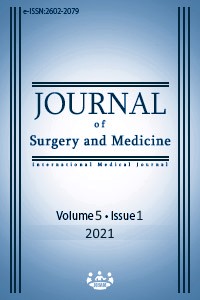Single incision-two port laparoscopic tubal ligation versus conventional three port laparoscopic tubal ligation: A prospective comparative study
Keywords:
Single incision laparoscopy, tubal ligation, conventional laparoscopyAbstract
Background/Aim: Most women who have completed childbearing request tubal ligation, as it is an effective and irreversible form of contraception. Single incision laparoscopic surgery (SILS) which is currently standard in most surgical specialties, eliminates multiple port incisions and provides faster recovery with better cosmesis. However, there is less data about single incision laparoscopic bilateral tubal ligation. We aimed to compare the results of single-incision-two port laparoscopic tubal ligation and conventional three port laparoscopic tubal ligation. Methods: Patients who desired tubal ligation procedure as a contraceptive method were randomly allocated to two groups as single-incision-two port laparoscopic tubal ligation (Group 1) and conventional three port laparoscopic tubal ligation (Group 2) between April 2015 to January 2020 in the Obstetrics and Gynecology clinics of two university hospitals. A prospective comparative study was conducted, and sixty patients were included in each group, which were compared in terms of operation time, blood loss, length of hospital stay, complications, port site hernia, postoperative pain score, conversion rate, cosmesis and failure of sterilization. Results: There was no need to convert to open surgery in either group. Average blood loss was similar between the groups (107.6 ml vs 98.4 ml, P=0.14). Operating time was significantly longer in group 2 compared to group 1 (38 minutes vs. 26 minutes, P=0.02). Higher pain scores were observed in group 2 compared to group 1 at the 24th postoperative hour (2.21 vs 3.82, P=0.012). Patients in group 1 were more satisfied with the single incision in the umbilicus based on cosmetic outcome scores (4.88 vs 3.16, P=0.018). There were no reported intraoperative complications in either group. No port site hernias and failure of sterilization were observed in any of the patients. All patients were followed up for a mean of 19 months (range: 12–60 months). Conclusion: Single incision two port laparoscopic tubal ligation does not increase the risk of complications and appears safe. It provides better cosmetic outcomes and lower pain scores compared to conventional laparoscopy.
Downloads
References
Rupp CC, Farrell TM, Meyer AA. Single incision laparoscopic cholecystectomy using a "two-port" technique is safe and feasible: experience in 101 consecutive patients. Am Surg. 2011;77(7):916-21.
Wheeless CR. Elimination of second incision in laparoscopic sterilization. Obstet Gynecol. 1972;39:134–6.
Taşdemir N, Abalı R, Çelik C, Aksu E, Akkuş D. Single-incision-two port laparoscopic tubal ligation: A cost comparison and technique description. J Turk Ger Gynecol Assoc. 2015;16:30-1.
Till H, Wachowiak R, Waldschmidt U, Metzger R, Hirsch W, Christiansen H. Single incision laparoscopic surgery (SILS) for ovarian masses (including teratoma) in adolescent girls. Eur J Pediatr Surg. 2010;20(6):425-6.
Jackson TR, Einarsson JI. Single-incision laparoscopic myomectomy. J Minim Access Surg. 2011;7(1):83-6.
Tormena RA, Ribeiro SC, Maciel GA, Baracat EC. Single-port laparoscopic hysterectomy: preliminary results. Rev Assoc Med Bras. 2015;61(5):446-51.
Ryder RM, Vaughan MC. Laparoscopic tubal sterilization. Methods, effectiveness, and sequelae. Obstet Gynecol Clin North Am. 1999;26(1):83-97.
Wheeless CR Jr. Laparoscopy. Clin Obstet Gynecol. 1976;19(2):277-98.
Pelland PC. Sterilization by laparoscopy. Clin Obstet Gynecol. 1983;26(2):321-333.
Yoon IB, King TM. A preliminary and intermediate report on a new laparoscopic tubal ring procedure. J Reprod Med. 1975;15(2):54-6.
Antoniou SA, Morales-Conde S, Antoniou GA, Granderath FA, Berrevoet F, Muysoms FE; Bonham Group. Single-incision laparoscopic surgery through the umbilicus is associated with a higher incidence of trocar-site hernia than conventional laparoscopy: a meta-analysis of randomized controlled trials. Hernia. 2016;20(1):1-10.
Perivoliotis K, Sarakatsianou C, Tepetes K, Baloyiannis I. Single incision laparoscopic fundoplication: A systematic review of the literature. World J Gastrointest Surg. 2019;11(3):179-90.
Karasu Y, Akselim B. Feasibility of single-incision laparoscopy for ruptured ectopic pregnancies with hemoperitoneum. Minim Invasive Ther Allied Technol. 2019;28(1):46-50.
Navarra G, Pozza E, Occhionorelli S, Carcoforo P, Donini I. One-wound laparoscopic cholecystectomy. Br J Surg. 1997;84(5):695.
Rupp CC, Farrell TM, Meyer AA. Single incision laparoscopic cholecystectomy using a "two-port" technique is safe and feasible: experience in 101 consecutive patients. Am Surg. 2011;77(7):916-21.
Vatansev C, Simşek G, Küçükkartallar T. Single incision laparoscopic appendectomy with two port: a case of appendiceal mucocele. Indian J Surg. 2013;75(Suppl 1):382-4.
Downloads
- 643 576
Published
Issue
Section
How to Cite
License
Copyright (c) 2021 Adeviye Elçi Atılgan, Ali Acar, Fatma Kılıç, Şükriye Leyla Altuntaş, Asiye Uzun, Derya Yaşar
This work is licensed under a Creative Commons Attribution-NonCommercial-NoDerivatives 4.0 International License.
















